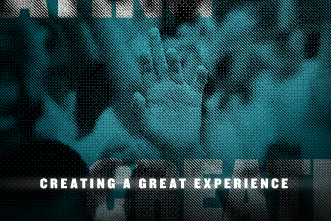At Catalyst, we take a tremendous amount of pride in creating a unique and unmatched experience for our community of leaders at our events. This takes a constant focus and a significant amount of time, energy, preparation, debate, and continual improvement.
Many leaders think that a great program/experience is just based on great talent on stage. That is important, but it’s only a part of what it takes to create a memorable program. Here are 11 key elements of a great program and unmatched experience in the local church.
1. Content is king. It all starts with content. Without great speakers/communicators who can deliver, you’re climbing uphill. Leverage the best communicators and speakers on your team and in your congregation. Just because you’re the senior pastor doesn’t mean you have to be the senior communicator.
2. Know your audience. Aim small in terms of your target. Many churches miss on this one. We want to be a place where all feel welcome. That is a great mission statement, but it can cause you to miss with what happens in your Sunday services or special programming. Be very specific in terms of who you are creating an experience for. Aim big, miss big. Aim small, miss small. And if the audience you are reaching is you, you’re probably off the mark.
3. Creativity often requires conflict, complication, and frustration. Everyone wants to know how to deliver creatively. But getting there is often a course in patience, conflict resolution, and hours of frustration. Great ideas and great programming are usually the result of healthy tension and debate over many meetings and many months. It’s a process. I always encourage young leaders that just when they think a great idea is the farthest away is usually when it’s closest. Push through the tension.
4. Find talent everywhere. This is so important for church leaders. We sometimes think that the only place we can find talent is on our staff. Not true. If you can’t hire someone full-time, then bring them in as a consultant, a volunteer, or for a day to bring fresh ideas and different perspectives. When you’re in the middle of planning and producing every day, it’s good to have someone from the outside provide perspective. My friend Jeff Henderson at Buckhead Church in Atlanta does this all the time. He brings in business leaders, authors, other church leaders, and those outside the church to speak to staff, help with music, and provide feedback.
5. Understand the difference between producing, directing, and leading. For Catalyst, different people with different responsibilities fill each of these roles. It gives our team the ability to see what is happening from a different vantage point and react/respond appropriately. And it requires different kinds of people. It’s important to not just have the same person filling these strategic areas unless your event is basic and not in need of a comprehensive production team. Even then, fill the roles and allow teamwork to flourish so when the time comes for a more complicated program, you are ready.
6. Focus relentlessly on transitions. This is the one thing I see so many churches and organizations fail at, mainly because they don’t spend any time on it. Many times, producers focus so much on the speaking, the music, or the key production parts that they end up leaving the transitions to chance. It’s essential to have transitions that are seamless, experiential, and connect with the audience. You can instantaneously lose your audience with a transition that is disruptive and unorganized.
7. Engage all of the senses. Taste, touch, smell, sight, hearing. Hit all of them as much as possible. Most events or experiences only focus on seeing and hearing. Disney is the best I’ve ever seen at this. Cirque de Soleil and Blue Man Group do this incredibly well, too.
8. Video screens can be one of your greatest assets or biggest barriers. Everyone thinks that they have to do IMAG screens and lots of video elements, but not anymore. If it’s not HD quality and really well done, it can be a hindrance. If you are leveraging video as a key part of your program, invest heavily in quality. We are all so used to great video quality in any and every environment that seeing something of lesser quality at church can be a hindrance and a turn off.
9. Know your programming grid and stick to it. A proper balance of challenge/light/funny/serious is a good grid for the rhythm of your programming. There are a lot of combinations of these four elements, so find one that works for you. Always build in margin through humor and intentional moments of light-heartedness. Otherwise, people will check out.
10. Learn from those who are more talented, have more money, create bigger events, and know more. Regardless of industry or background, learn from those who are the experts. We’re never too good or too big or too experienced to learn from someone else. Every event I attend is a great learning experience for me, and I try to take notes, talk to the directors, and find ways to improve on what we are creating.
11. Share what you know. We are all on the same team. Higher tides lift all ships. We should be intentional about sharing what we know with others in order to make us all better. And ultimately, collaboration reflects how we as the Church should be working together and demonstrating the love of Christ.
It’s important that we start and end with this: God demands excellence from us. And excellence is not about having more money, more staff, or more talent. Excellence is a choice. It’s setting a standard and living up to it. And our Creator wants a level of creativity in our churches and in our programs that is at the highest level. We are commanded and required to deliver.













